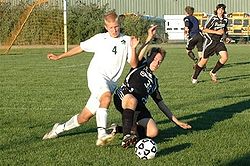
Sliding tackle
Encyclopedia

Tackle (football move)
Most forms of football have a move known as a tackle. The primary purposes of tackling is to disposses an opponent of the ball, to stop the player from gaining ground towards goal or to stop them from carrying out what they intend....
in soccer in which a player attempts to take the ball away from an opposing player by deliberately leaving his feet and sliding along the ground with one leg extended to push the ball away from the opposing player.
Sliding tackles can often be sources of controversy, particularly when players being tackled fall down over the tackler's foot (or the ball stopped by the tackler's foot), and penalties, free kicks and cards are assessed (or are conspicuous by their absence).
Commonly associated fouls and misconduct
A sliding tackle is not in itself foul play, however there are a number of foulFoul (football)
A foul in association football is an unfair act by a player which is deemed by the referee to contravene Law 12 of the Laws of the Game.For an act to be a foul it must:...
s that commonly occur during the execution of a sliding tackle.
Examples of such fouls punishable by a direct free kick
Direct free kick
A direct free kick is a method of restarting play in a game of association football following a foul. Unlike an indirect free kick, a goal may be scored directly against the opposing side without the ball having first touched another player.-Award:...
or penalty kick
Penalty kick
A penalty kick is a type of direct free kick in association football, taken from twelve yards out from goal and with only the goalkeeper of the defending team between the penalty taker and the goal.Penalty kicks are performed during normal play...
include:
- When a player tackles an opponent to gain possession of the ball, making contact with the opponent before touching the ball;
- When a player in a manner considered by the referee to be careless, reckless or using excessive force:
- kicks or attempts to kick an opponent;
- trips or attempts to trip an opponent;
- raises his/her football boots perpendicular to the field.
Playing in a dangerous manner is punishable by an indirect free kick
Indirect free kick
An indirect free kick is a method of restarting play in a game of association football. Unlike a direct free kick, a goal may not be scored directly from the kick. The law was derived from the Sheffield Rules that stated that no goal could be scored from a free kick...
.
A foul sliding tackle may also constitute misconduct
Misconduct (football)
Misconduct in association football is any conduct by a player that is deemed by the referee to warrant a disciplinary sanction in accordance with Law 12 of the Laws of the Game. Misconduct may occur at any time, including when the ball is out of play, during half-time and before and after the...
, resulting in either yellow card (caution) or a red card (send off). In particular a tackle "which endangers the safety of an opponent, must be sanctioned as serious foul play" (i.e. the player must be sent off).
Slide tackles from behind or with both legs extended have now been outlawed due to the injury and danger to other players that it causes. These tackles generally earn the player who commits them a straight red card, even if the ball is won cleanly and the tackle is not technically a foul.
Strategy
The slide tackle is attractive to the defenderDefender (football)
Within the sport of association football, a defender is an outfield player whose primary role is to prevent the opposition from attacking....
because they allow him or her to cover a larger area of ground while attempting to dispossess an opponent. It is often a last gasp attempt to dispossess an opponent due to frequent misses and the difficulty of recovering in the event the slide tackle fails to take the ball away. After a slide tackle, the tackler is left sitting or lying on the ground with one leg extended. The defender also runs the risk of personal injury. Ideally, the other foot ends up folded underneath their rear end, where it can be used to push the tackler back up to their feet to continue play.
If doing a sliding tackle to the right the player's right leg must be straight when going down into the tackle and their left leg should be bent slightly behind the right one in order to achieve maximum potential in gaining the ball. If doing a sliding tackle to the left the player's left leg must be straight and their right leg should be bent slightly behind the left one in order to achieve maximum potential in gaining the ball.

